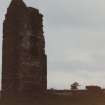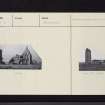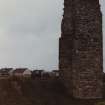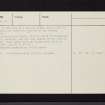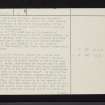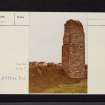Following the launch of trove.scot in February 2025 we are now planning the retiral of some of our webservices. Canmore will be switched off on 24th June 2025. Information about the closure can be found on the HES website: Retiral of HES web services | Historic Environment Scotland
Corsehill Castle
Castle (Medieval)
Site Name Corsehill Castle
Classification Castle (Medieval)
Alternative Name(s) Reuincraig; Old Crosshill
Canmore ID 42919
Site Number NS44NW 6
NGR NS 41721 46575
Datum OSGB36 - NGR
Permalink http://canmore.org.uk/site/42919
- Council East Ayrshire
- Parish Stewarton
- Former Region Strathclyde
- Former District Kilmarnock And Loudoun
- Former County Ayrshire
NS44NW 6 41721 46575
See also NS44NW 10.
(NS 41721 46575) Corsehill Castle (NR) (rems of)
OS 6" map (1970)
The map in Pont's 'Cuninghame' of 1604-8 shows two buildings, "Reuincraige" and "Corshill", at approximately NS 417 467 and NS 422 465 respectively, and Dobie (1876) comments that the two have often been confused, but that "Reuincraig" stood on the W of the Corsehill Burn (presumably that now called Clerkland Burn) and "Corsehill Mansion" on its E.
"Reuincraig", he says, was so modernised about 1840 that it was difficult to realise that it had been ruined in 1608, while the ruins of "Corsehill" were removed about the beginning of the 19th century and only foundations could be traced when he wrote. He also thought that "Reuincraig" (i.e. Ruin Craig) was not an original name.
If Dobie is correct, the ruins published as "Corsehill Castle" on the OS 6", must be those of "Reuincraig", both because they are standing remains, and because they are on the W bank of the burn.
Also, Macgibbon and Ross, describing "Corsehill Castle" at the end of the 19th century as a very ruinous mansion, evidently of late date and apparently of the L-plan, and ascribe it to the period 1542-1700, must be referring to "Reuincraig".
Grose, in 1791, publishes an illustration of "Corshill House", but does not give it a close siting. As, however, he mentions that "at a small distance from this ruin are some small remains of a more ancient building belonging to the same family", he is also probably referring to "Reuincraig", the "small remains" being those of "Corsehill".
Information from OS.
(F Grose 1791; D MacGibbon and T Ross 1889)
Field Visit (2 February 1962)
The remains at NS 4173 4658 consist of a single wall fragment measuring 5.8m long by 2.8m thick, and about 10.0m high, with a fireplace visible in the E side, which, considering the repairs said to have been done in 1840, bears a sufficiently close resemblance to the wall shown on the left side of Grose's illustration to confirm this as his "Corshill House". To the W of the wall is a ditch 7.0m wide with a maximum depth of 2.5m, and on its S are traces of another ditch about 3.0m wide and 1.0m deep, but this appears to be the remains of a track which led from the modern road on the W side of the castle to the cattle creep under the railway line on the E side, but it may have been original before it silted up.
On the N of the site is a natural gully, and on the E a rock outcrop now partially covered by the railway embankment.
Irregular-shaped banks, through which odd fragments of masonry protrude, are all that remain of the rest of the castle; these banks vary in height from 0.3m to 1.7m. (See also NS44NW 10).
Earthworks surveyed at 1:2500 scale.
Visited by OS (EGC) 2 February 1962
Field Visit (25 October 1982)
No change.
Visited by OS (JRL) 25 October 1982.
Note (19 October 2020)
Roy’s Military Map of 1747-55 indicates that 'Old Crosshill', a medieval castle (NS44NW 6), stood on the W side of the Clerkland Burn, while 'Crosshill', a post-medieval house and its successor (NS44NW 10), stood on the E.
It is likely that the image from 1789 of ‘Corshill House’ published by Grose shows the eastern and more modern of these two houses (contra OS (EGC) 1962), the site of which is now beneath a housing estate.
Information from HES Survey and Recording (GFG), 19 October 2020.















